Elizabethton Star


Downtown Elizabethton early 1950s
Take a glimpse into the rich heritage of Carter County through contributed photographs, timeline and other historical memorabilia.




Take a glimpse into the rich heritage of Carter County through contributed photographs, timeline and other historical memorabilia.

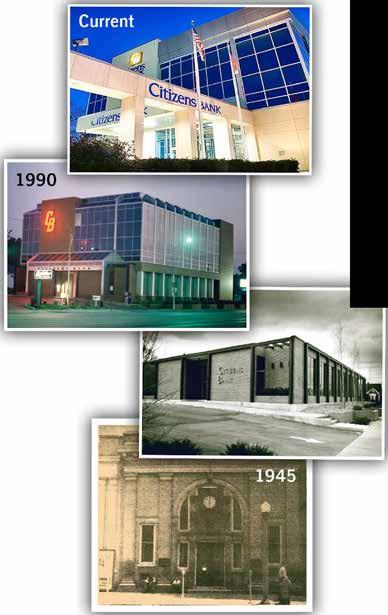
Since 1934, Citizens Bank has continued to grow with the community. This year, the bank was able to secure approval for over $173 million in SBA PPP Loans for more than 2,000 small businesses. And, we are looking forward to the future!

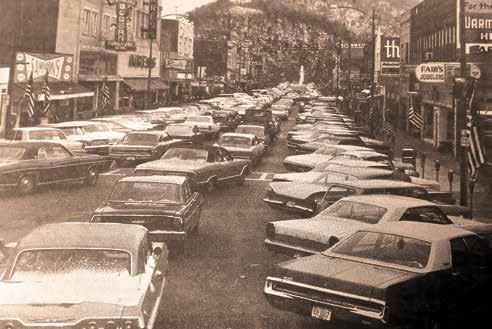
In the heart of Elizabethton, a town nestled in the bosom of Carter County, Tenn., the 20th century was a time to cherish and savor. The charm of those years still lingers, a memory of a wonderful time to love and live in this close-knit community. As the sun dipped below the horizon, casting a warm golden glow over Elk Avenue, the heart of downtown, it seemed as if life itself slowed down to savor every moment.
Elk Avenue was a bustling hub of activity, lined with shops and stores that held the dreams and desires of the locals. Kress and Eagles, the five and dime stores, welcomed shoppers with an array of goods, while Watsons, C & L and J.C. Penney’s dressed the townsfolk in the latest fashion. A massive dollar store stood as a testament to affordability. For those who loved tinkering with cars and bicycles, Advance and Western Auto supplied the tools and parts they needed. Life was an open road, just waiting to be explored.
Downtown Elizabethton was a true entertainment paradise. Movie theaters were scattered like gems throughout the town,
each with its unique charm – The Ritz, The Capitol, and The Bonnie Kate. Brumit’s Sports Shop was a haven for sports enthusiasts, boasting uniforms and trophies that every young athlete aspired to own. It was a town where sports dreams were made and cherished.
Bank upon bank stood as pillars of financial stability – Citizens Bank, Carter County Bank, Security Bank, Elizabethton Federal Savings, Northeast Credit, and Happy Valley Credit Union. They were the guardians of hard-earned savings, trusted and revered by the townsfolk.
When hunger beckoned, Elizabethton had an answer. Dino’s served up the finest Italian cuisine, while Southern, run by the Coffman family, dished out hearty, homecooked meals that tasted like love on a plate. The bus station was more than just a transport hub; it was a gateway to adventure. It offered the possibility of leaving Elizabethton behind and embarking on a journey across the United States. The station’s grill and homemade goods kept travelers well-fed on their voyages.
Bakeries downtown created pastries and bread that were beyond compare. Each bak-


The Eagles Store, located at 507 E. Elk Ave.,, is a true testament to the town’s rich history and enduring spirit.
ery had its unique flavor, and choosing a favorite was an impossible task. Lynnwood Hotel offered a breathtaking stay with views of the mountains and the gentle river running nearby. It was the ultimate escape, a retreat that filled the soul with tranquility.
Elizabethton was proud of its history, with a covered bridge, a magnificent monument, and a solemn war memorial wall that paid tribute to the town’s heroes. Florists adorned the streets, their blooms bringing color and life to the town. News could be found at M&N News, and furniture stores offered pieces to turn houses into homes. Shoe stores ensured that everyone walked in comfort and style.
Jewelry stores were plentiful, with Fred Davis, Peters Jewelry, and Winston Jewelry owned by the Peters Brothers, and Ray Fair, who offered a touch of grace and flexibility for those in need. Love stories were written in silver and gold, and timeless treasures were passed from generation to generation.
Elizabethton may have transformed over the years, but the essence of those wonderful days still echoes in the streets. It was a time when the town had it all, a place where love and life intertwined, creating a tapestry of cherished memories.
Where drug stores like Burgies, Taylor Drug, and Lingerfelt boasted bustling soda fountains and cozy eateries on every corner. Locals gathered for root beer floats and burgers, sharing laughter and stories. Those iconic establishments, once vibrant hubs of the community, have now faded into memory, but their spirit lives on in the hearts of the city’s residents, a reminder of the bygone era when life was simpler, and downtown was the heart of it all.
In 1954, this beloved establishment opened its doors, boasting a newly constructed three-story building that quickly became a local icon. Originally conceived as a five and dime store, the Eagles Store catered to the community’s every need and want, offering a wide range of goods that could satisfy any shopper’s desires. It rapidly became a cornerstone of the community, serving as a hub for social gatherings and commerce.
For nearly three decades, the store thrived, until it closed its doors in 1983. However, its story was far from over. The building was generously donated to Tusculum College, showcasing the community’s commitment to education and preservation of its history.
Over the years, the Eagles Store’s ownership changed hands. Lois Greene became its steward, then Bill Carter, who diligently purchased and managed the store from 2003 until 2018. In a poetic twist, the store was eventually acquired by John and Lisa Bunn, former proprietors of the nearby Coffee Company. The Bunns continued as an antique store, breathing new life into the historic building.
In 2020, the ground floor was opened, offering even more treasures for shoppers to explore. And in 2023, Tammy Troutman took the reins, continuing the tradition of the Eagles Store as an antique haven. Today, the store is a testament to the enduring spirit of Elizabethton and the resilience of businesses that have left an indelible mark on the community.
Open daily from 10 a.m. to 5 p.m., Monday through Saturday, the Eagles Store, now an antique emporium, stands as a living testament to the town’s heritage and the unbreakable bond between the people and their history.


In 1963, a man named Dino Senesi embarked on a culinary journey that would forever change the dining landscape in East Tennessee. Dino’s Restaurant, a cozy Italian eatery, became a local legend when it served the first lasagna in the region. The scent of simmering sauces and freshly baked pasta wafted from Dino’s modest walk-up window, captivating the taste buds of Elizabethton’s residents.
As the years rolled by, Dino’s popularity continued to grow. In 1965, he expanded
James Robertson and Daniel Boone were the first European explorers to come to Elizabethton, arriving in 1759
his culinary haven by adding a small dining room, complete with four cozy booths and six bar stools. Diners could now savor their favorite Italian dishes in a more comfortable setting. Dino’s warm smile and dedication to his craft made the restaurant a cherished gathering place for locals.
By 1969, the demand for Dino’s delectable cuisine was undeniable. He further expanded, adding nine tables and a TV set to accommodate a growing clientele. The new, larger dining area created a welcoming atmosphere, where friends and families could share memorable meals and cel -
Settlers of northeast Ten nessee needed to establish some kind of law and order and organize defense against attacks. They met at Sycamore Shoals to fonn the Watauga Association in 1772.
Today this is considered to be the first majority-rule American democracy/
ebrate special occasions.
Dino wasn’t just a restaurateur; he was a pillar of the community. He proudly supported sports in Carter County, particularly as a devoted fan of the Elizabethton Twins, a local baseball team. His commitment to the community extended to the Boys and Girls Club of Carter County, where he lent a helping hand.
One of Dino’s most beloved dishes was his spaghetti with his secret homemade sauce, a closely guarded family recipe. For decades, he delighted patrons with the rich, flavorful sauce that clung perfectly to al
dente pasta, creating a taste that was nothing short of magical.
However, in the mid-1990s, Dino decided it was time to pass the torch. The restaurant found new ownership in the form of Kent Williams and his family, who continued the tradition of exceptional Italian cuisine. A native of Scranton, Pa., Kent had spent the last 50 years in Elizabethton, making him the ideal custodian of Dino’s legacy.
Dino’s Restaurant remained a beloved fixture in the community, where new and familiar faces could still experience the magic of that first lasagna served in 1963.
Sinking Creek Baptist Church is the oldest church in Tennessee. It was organized 1772 in Washington County (now Carter County) and is the oldest church in Tennessee still in existence at its original location.


The Watauga Association at Sycamore Shoals near Elizabethton drafted the first constitution ever written by white men in America in 1772. It was patte rned after the con stitution of the Iroquois League of Nations, a federal system of government devel• oped 200 years earlier for five eastern Native American 1772
Early during the American Revolutionary War, Fort Watauga at Sycamore Shoals was attacked in 1776 by Dragging Canoe and a warring group of Cherokees opposed to the Transylvania Purchase

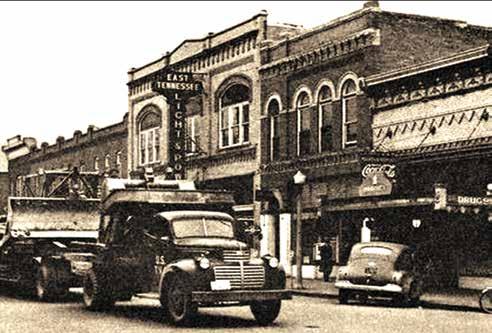
The Grand Theatre, a cherished historic landmark located on the third block of Elk Avenue in downtown Elizabethton, has a rich and enduring history that has captivated residents for over a half century.
This iconic theatre first opened its doors to eager audiences in the early 1900s, showcasing a dazzling array of silent films. In 1918, it saw a turning point when F.E. Perryman became its owner, ushering in a new era of entertainment.
In 1920, the Grand Theatre was alive with excitement as “The Silent Avenger” graced its silver screen, captivating the imaginations of the audience.
However, tragedy struck in 1927 when a devastating fire erupted in the projection room, ravaging the theatre and causing around $10,000 in damages to neighboring businesses, including Burgie Drug and Holston National Bank. Remarkably, all 300 patrons inside the theatre during the incident managed to escape unscathed. The fire was attributed to the film spontaneously igniting upon contact with the projector’s powerful arc light.
In a testament to the resilient spirit of the community, the Grand Theatre was swiftly rebuilt, complete with a new lobby and modern

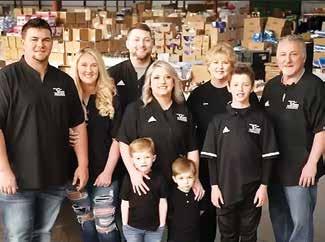

amenities. Just in time for December, it reopened its doors, premiering “An American Beauty.” The renovations included a fireproof projection room housing two brand-new projectors, and the theatre’s seating capacity was increased to accommodate 350 eager patrons.
Notably, the year 1951 marked another significant milestone in the Grand Theatre’s history. On January 14, the beloved establishment was rechristened as the “Betsy Theatre,” solidifying its place as a cherished cultural institution in Elizabethton.







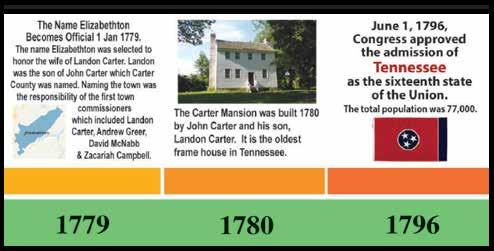




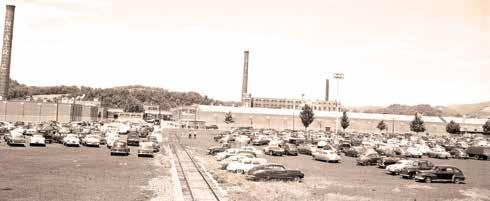
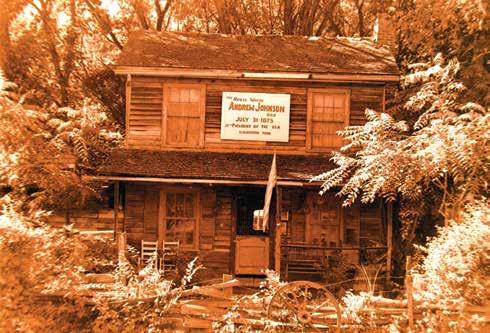




Andrew Johnson, the 17th President of the United States, was a man whose life intertwined with the rich tapestry of history. Born into poverty and self-educated, Johnson rose through the ranks of American politics to become a senator, governor, and, ultimately, the President.
In 1865, Johnson assumed the presidency following the tragic assassination of Abraham Lincoln. His tenure was marked by the complexities of post-Civil War Reconstruction, as he grappled with the immense task of bringing the nation back together.
Years later, as his life neared its end, Johnson found himself returning to the place he called home. On his journey back from Washington D.C., he passed away in the house of his daughter, Mary Johnson
Stover, located in Elizabethton, Tenn.
This historic house, a symbol of his enduring connection to the region, once stood near Fudd’s Country Store, just across the street from Elizabethton Ford. Today, this house, which witnessed the final moments of the former President’s life, resides at Dr. Dan Schumaier’s home in Stoney Creek.
The house has been meticulously restored, adorned with furniture from the same time period. It stands as a living testament to Johnson’s legacy and the era in which he lived. On July 31, 1875, Andrew Johnson passed away, but his impact on American history endures, not only through his tumultuous presidency but also through the preservation of this piece of history in the heart of Elizabethton, Tenn.
Sinking Creek Baptist Church is named for a tributary of the Watauga River. It is located on the Old Elizabethton Highway in Carter County. It is the oldest church in the state of Tennessee still in existence at its original location. It was organized in 1772 in Washington County (now Carter County).
Matthew Talbot was the first pastor. Worship services have continued through the years except during the Civil War from 1861 to 1865. In 1778 evangelists Charles and John Chastain, brothers from Virginia, held a revival here and the need for a larger church was realized. Pastor Talbot, Joshua Kelly, and a Mr. Maulkey planned and erected what is now known as the “Old Log Church” that still stands today with many of its original logs intact. Because of its legendary past it is now a historical landmark and shares the same grounds as the new church built in 1962. E. Reece Harris was the longest-standing pastor to the congregation. He served from 1962-2012. The present pastor is Chuck Babb.






Siam Baptist Church celebrated its 150th anniversary in October. Siam’s first pastor was John Leonard Bowers, who was born in 1830. Construction on the present church building was begun in 1933. River rock, a featured part of the building, came from “across the river.” The rocks had been screened from sand by a company hauling sand from that area. The limestone rock which adorns the building came from Lynn Mountain and from the farms of Aunt Carr Allen and Bill Allen. It was dedicated on Oct. 11, 1936. An educational wing was added to the building in the 1960s. One of the best known members of the congregation has been Miss Olive Allen, who served as a Southern Baptist missionary to Thailand and Vietnam

First United Methodist
First United Methodist Church celebrated its 190th birthday this year. The church had its origin in 1833, moving to different locations in its earlier years. Elizabethton became the circuit headquarters, and from here Methodists radiated into various communities in the county. Until about 1820 Duffield Academy served as a “Union Church” where all the people came together to hear any preacher who happened to come into the town. The Methodists soon made efforts to establish a meeting place of their own. John Singletary, a local preacher and a hatter by trade, took the lead in constructing a log cabin on North Main Street in 1820. The Civil War, which divided the nation as well as families, also split the Elizabethton Methodist Church. The northern part of the congregation remained on First Street, and the southern Methodists moved to the Presbyterian church until 1888 when they built their own brick church on Second Street. In 1913 the northern
Methodists built a large brick church on F Street which became known as Singletary Memorial. In 1936, Singletary was dropped from the name, and the church was known as Memorial Methodist Church. The southern congregation continued to meet on Second Street in the present St. Thomas Episcopal Church building until 1924, when a new church was begun on E Street, which is now First United Methodist Church. Beginning in 1939, following a new generation of members in each church, the two congregations began having some services together, including Sunday night worship, revivals, and Vacation Bible School. Soon, the two congregations merged, and in September 1944, met to select a new name for the group, selecting First Methodist Church. Thus, some 80 years after the Civil War, and with a new congregation of members, the factions that had so divided the congregation had been forgotten, and now the church was one again.



St. Thomas Church was originally old Southern Methodist Church
One of the oldest churches in town is the St. Thomas Episcopal Church located next to the Carter County Courthouse.
The church was originally the old Southern Methodist Church.
When the Methodist and Presbyterian were the only two churches in town, one church held services in the morning and the other in the afternoon, so everyone could attend both services. The sermons at the services lasted sometimes two to two and one-half hours.
In 1844, when the Mason and Dixon Line was the dividing line between the northern and southern churches, the Methodist congregation was divided to some extent, as it was then known, had begun meeting in a building on Second Street, which was constructed about 1859 and completed a year or two later.
But due to a debt on the church property the building was lost during the years of the Civil War. In 1870 the Presbyterians opened their doors to the congregation and they worshiped in their church with a circuit riding preacher coming once a month to preach and hold School School in the afternoon. At this time the membership was largely made up of the Hunters, Tiptons, Jobes, Crumleys, St. Johns and Wilcoxes. The Rhudys and Dungans became a part of the
church around 1880, when a building committee was appointed to erect the church that is now used by the St. Thomas Episcopal Church. The church was completed and dedicated in May 1988.
The lot for the church building was purchased from William and Mary Shell for the price of $200.
In 1924, the congregation was still meeting in the small building on Second Street, when at a woman’s meeting at the home of Dr. and Mrs. J.O. Woods, the president of Bristol Sullins College, Dr. W.S. Neighbors, urged the ladies and the congregation to enter a building program for a bigger church and in the new part of town. Two ladies, Mrs. Alice Dungan and Mrs. Carrie Taylor, accepted the challenge and began soliciting pledges and subscriptions to build a new church. A building committee of Sexton Dungan, W.D. Rhudy, J.C. Crumley and Wilkie Edens was selected to oversee the construction.
In November 1926, groundbreaking ceremonies were held for the new church on E Street (site for the present First United Methodist Church).
The ladies of the church sponsored numerous bazaars at the old Lynnwood Hotel, along with Thanksgiving dinners and chicken suppers, to raise funds for the






church building fund.
Upon the move to the new church, the name of the new church was changed from South to Central.
In the meantime, the northern faction of the Methodist Church had been meeting in an old building on First and Academy Street. In 1913 the congregation built a new and modern church on F Street. The church was called the Singletary United Methodist Church. Later, around 1939, the name was changed to Memorial Methodist Church.
Beginning in 1939 following a new congregation of members in each church, the two congregations began having some services together such as Sunday night worship, revivals and Vacation Bible School, Soon the two congregations merged and in September 1944, both congregations met to select a new name for the merged group, selecting the name First Methodist Church.

Thus, some 80 years after the Civil War and with a new congregation of members, the factions that had so divided the congregation had been forgotten, and now the church was one again.
This year, First United Methodist Church, a member of the Holston Methodist Conference, celebrated its 190th anniversary. The congregation continues to meet in the church (originally the new Southern Methodist Church) on E Street.


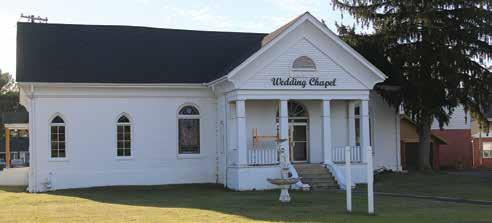
The old Presbyterian Church on Main Street, now a wedding chapel, is one of Elizabethton’s oldest churches, serving the Baptists and Methodists, and several other congregations through the years.
The Elizabethton Presbyterian Church dates back to 1825. Among the first members were names such as Cameron, Carter, Taylor, Stover, Duffield, and Smith.
During the ministry of the Rev. James McLin, the building on N. Main Street was erected. Prior to that time the congregation had met in the courthouse. In 1187, under the supervision of Dr. Cameron, the building underwent extensive repairs.
The Civil War also affected the Elizabethton Presbyterian Church, almost forcing it to close. Many of the leading families were slave owners, and during the years of 1861-65, the removal of scores of members to other parts threatened the very existence of the congregation. A few staunch members, however, among whom were Dr. James M. Cameron and his family, remained active and because of their efforts the congregation was able
to continue its activities.
Dr. Cameron and his two brothers, M.D.L. and John W. Cameron, though the family owned slaves, were among the most active and fearless of the supporters of the Union cause. Dr. Cameron served during the war with the 13th Regiment as an assistant surgeon, and was held in high esteem by the members of the Regiment, both officers and soldiers.
His mother, Mrs. Jane Cameron, had owned slaves when the war began.
However, after the war Dr. Cameron gave much of his time to church and Sunday School interests.
During the ministry of the Rev. H.C. Atwater, which began in 1870, great interest was awakened in the church. He was a powerful preacher and a diligent pastor and through his efforts the congregation was rehabilitated.
The Elizabethton Presbyterian and Methodist Churches were leaders in the local temperance movements, which dated back to 1840.
The congregation worshiped on Main Street until the early 1950s when it bought property on F Street and built a new church.



On Sunday, Oct. 1, Hale Community Ministries, an outreach of Watauga Association of Baptists, celebrated 30 years of service with a get-together for members, volunteers and neighbors.
“We appreciate everyone who came to help us celebrate the 30th anniversary of Hale Community Ministries,” HCM Director John Shook said. “We enjoyed great fellowship with friends, as well as looking at pictures taken through the years and talking about the many wonderful memories of the people we met, special ministry events and the many ways we have seen God at work.
“It was great to be reminded of God’s faithfulness in the past and knowing He will never change.”
The beginnings of HCM came in 1991, under leadership of its newly elected director of missions, Bob Polk. He and other visionary leaders of Watauga Baptist churches identified two important needs in local communities: helping people and providing local opportunities for church members to be on mission.
The idea for HCM had been germinated but there was no leader. “Then, through a turn of events that only God could produce, Becky Brumitt lost her job,” Polk recalled in a story from HCM’s celebration event.
“Having recently returned ‘on fire’ from a mission trip,” the story related, “Brumitt began as a volunteer. In 1993 she was elected the first director of church and community ministries, leading a ministry named in memory of Gertrude Hale, a much-loved former missionary in the association.
“Operating from a little white building on Blevins Avenue, in its first six months HCM fed 635 people,” as well as providing clothing, firewood, meals for Thanksgiving and Christmas, and Christmas gifts. Local pastors provided spiritual counseling and, most importantly, four people made professions of faith during that short time.
Sharing the gospel has always been the most important principle of HCM’s core values.
The other was generous giving. “I remember Bob Polk telling me ‘If they need it and we have it, we will give it to them.’ There was such freedom in that,’” Brumitt said. And that’s how people in need were being served and how church members were finding ways to serve the Lord, all without leaving home.
Churches in the association responded generously as Brumitt visited and told the

stories of HCM. “I rarely left a church without having money slipped into my hand or finding out later that the church had voted to give monthly to HCM,” Brumitt said in HCM’s brochure.
After a few years a new facility became needed because the building at the original site on Blevins Avenue had boring bees, swarming termites, snake skins in the cabinets and sewer rats coming out of the toilet.
The association obtained property on Arney Street and built the current building, which offered more space for organizing food and clothing, and space for Bible studies, including a weekly Bible club for children called Big A Club.
In time, in addition to the early ministries, HCM conducted block parties, provided

home repairs, donated school supplies, supervised summer missionaries and more. As needs and opportunities expanded in Johnson County, a building was opened there. HCM also is a partner in a church startup in the Lynnwood-Lynnridge community.
After 30 years, the organization is still helping people and providing opportunities for service in Carter and Johnson counties, now under the direction of Director John Shook, staff and volunteers.
You, too, can be part of HCM’s history. Volunteers are needed to serve on site. Supplies are always needed. Here is a list of their immediate needs:
• Groups to fill food distribution bags
• Parking lot repairs
• Painting
• Volunteer Bible study leaders
• Prayer walks
• Food donations
• Clothing donations
• Groups to complete minor home repairs
• Gravel for driveway at Lynnridge Church
• Groups to provide house cleaning for shut-ins
• Volunteers to deliver food boxes
• Sponsors and organizers for community block parties
• Coordinator for the Johnson County site
For more information, call 423-547-2560.
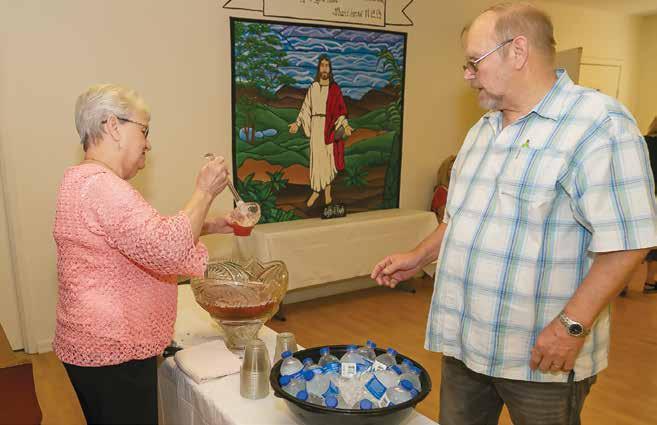




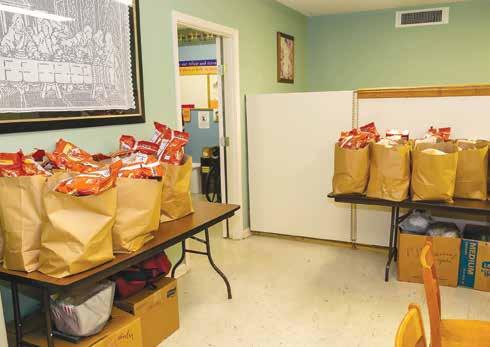
One of the biggest parts of Hale Community Ministries is their food pantry. They have bags of groceries ready to distribute to those in need. They are also asking for donations to help keep this vital service stocked and ready for those that need it most.



This could have been a basic story, simply telling the events leading up to the first organized classroom for local special needs children. Instead, it is the story of how a family’s love, commitment and determination brought special education to the schools in our community.
Two Elizabethton sisters, Sally Shook Harris and Ellen Shook Hutchins, were part of that journey and the way they look at it, it is also a story of the “incredible way God’s plan comes together.”
In the late 1930s when J. Ogden Shook and Florence Lucille “Tommie” Shook met in Knoxville, they had no idea where life would take them. Tommie was in nursing school and Ogden was in engineering school at the University of Tennessee. They married and moved to Elizabethton in 1940, where Odgen worked at North American Rayon Corporation and Tommie worked as an RN at the Franklin Hospital.
In 1943, the couple had their first child. Her name was Becky and tragically, only five years later, she died — the first child in Carter County to pass away in the polio epidemic.
Their second daughter, Sally, was born in 1946, and their son, Joseph Ogden (Joe) Shook, was born July 5, 1949. Joe was a Down Syndrome child.
“In those times, Down Syndrome children were often kept at home and were rarely seen in public,” Sally explained. But her parents did just the opposite, she said. They took Joe to church with the family from the time he was born. When the family went out, Joe was with them.
“He was a precious, sweet, and loving child,” Sally recalls. “He had all the experiences that every other child had – eating out, swimming, parties, vacations, church, playing with friends, etc. I never considered Joe any different because he wasn’t. We were a happy, active, normal family…and I’ve often said that Joe was the sweetest, most patient and loving member of our family.”
In the spring of 1955, the normal time for Joe and other children his age to start school, Joe’s mother took him to register in Elizabethton City Schools for the fall. “She was told at registration there were no classes for ‘children like Joe’ and that he could not go to school,” Sally recalls. “I remember her being very upset and disappointed.” Her parents refused to take “no” for an answer. They contacted the Superintendent of Schools, Tommy Dugger, and asked that Joe be allowed to attend school. Dugger told the couple there was no program or classroom space for these students.
However, Dugger did offer some hope. He said the school system would provide a teacher, but in order for that to happen, about 10-12 potential students would have to be identified. That was a tall order, Sally said. “Remember these children – for the most part – were unknown because parents kept them in the privacy of their homes. But when the search for these special children began, they almost came out of the woodwork. The number of children needed to create a class were identified very quickly. Other parents wanted them in school, too.”
After locating the required number of students, only one more roadblock remained – finding a classroom for them to meet. Ogden and Tommie had a plan for that too. In the summer of 1955,

the couple brought a construction team into their West D Street split-level home. They had decided their drive-under garage, located at the front of the house, would be the perfect place for a room and bathroom suitable for a school classroom. The construction was completed quickly, and just in time for school to begin. And so that summer, Superintendent Dugger sent a teacher to George Peabody College in Nashville for special training and certification to teach these special children. Her name was Vera Johnson.
“When Elizabethton City Schools started their 1955-56 school year, the first special education class started on West D Street, Elizabethton,” Sally said. “My father and some friends built special playground equipment and it was placed in the backyard so the children could enjoy physical education and recess just like the children in other schools. The equipment they built is still standing today – almost 65 years later.”
During the time on West D Street, Mrs. Johnson and an aide taught and loved their students, Sally recalls. A high school student walked up each day from Elizabethton High School, (the current T. A. Dugger Junior High School) to fix soup and sandwiches for lunch on a hotplate for the children.
The special education class met in the classroom on West D Street for about four years, and then a new classroom was provided at Lynn Avenue Elementary School. “I wonder if Mr. Dugger ever

realized what an impact his decision to listen to these parents would have on education in Elizabethton, Carter County, and possibly the entire region?” Sally added. And so, life went on for the Shook family in the usual way until 1959. That year Ogden lost his wife, and Sally and Joe – ages 13 and and 10 – lost their mother. He was now a widower with two young children, one of whom had special needs. And it is at this point that Ogden’s youngest child, Ellen Shook Hutchins, relates the rest of her family’s story: “At that time, in Lake Charles, Louisiana, my mother, Joye Vining, was a widow with a three-year-old son, George, who also had Down Syndrome. One day in early 1960, she was outside hanging up her laundry and her neighbor came running out to her with a copy of Reader’s Digest. In the publication, there was an article about a pastor who was starting a mail-in dating service. It apparently was a pretty intense application process – references from a pastor and business/community leaders were required. My mom’s neighbor insisted that mom request an application, and she helped her with the pageslong process.”
As it turned out, Sally and George’s dad, Ogden, also subscribed to Reader’s Digest, and he, too, had requested an application. And so, in April of 1960, those two people were ‘matched’ because they both had sons with Down Syndrome. And so the courtship began. Ogden and Joye started corresponding by mail and eventually talked on the phone. That fall, Ogden invited Joye to come for a visit. “Mom drove the whole way here, stopping in Little Rock to drop George off with her parents,” Ellen said. “When she got to Elizabethton, I’m sure she was given the royal treatment. I feel certain they went to a Cyclones football game, and then they went to a UT football game on that Saturday.” On Sunday, Ogden proposed. “He was smart,” Ellen said. “He had Sally, who was now a high school freshman, do the proposal. Mom accepted immediately, went back to Louisiana to quit her job and sell her house. She returned on November 4, and they got married after church that Sunday, the 6th. “I will add here that their friends, Bob and Marjorie Nelle Cardwell, were also very instrumental in the community of special education – and in my parent’s courtship,” Ellen noted.
Four years later, in 1964, Ellen was born. By this time George was 8, Joe was 15, and Sally was 18. And even though the family dynamics had changed, Ellen said her mother, Joye, jumped right in supporting the kids with needs in the community. “They didn’t skip a beat,” she said of her parents. “I vividly recall being part of this group of young special people who were so actively involved in the community. I learned to bowl with them on Wednesday afternoons, and square danced with them on Monday nights. The activities my parents and so many others arranged for them was amazing.” Ellen also remembers the special education class moving from Lynn Avenue School to Harold McCormick when it was built, and she has fond memories of the city’s first special education teacher, Vera Johnson, who she described as “truly one of a kind.” “I know for sure she taught through at least 1970, possibly 1971,” Ellen said. “She really became like a member of our family, long after she retired from teaching. She often came to Joe and George’s birthday parties, up until she passed away in the 1990s.”
In 1972, the Shook family once again had to deal with loss; Ogden Shook, who was a school board member at the time, passed away. “I was eight years old, and my mom was again a widow – this time with two sons and a young daughter to take care of,” Ellen said. Joye also served as an Elizabethton City School Board member (in the late 1970s-early ’80s), and worked as a real estate broker. She passed away in 1991.
Both brothers are also gone now – Joe passed away in 2019, and George in 2022 – but the Shook family’s legacy of commitment and passion for special education continues on. Ellen has been a special education teacher for 34 years, with 24 of those years in Carter County. Her daughter, Courtney Erwin, is also in special education, in her second year of teaching at East Side Elementary in Elizabethton.
“There is so much more to this story over the years,” Sally added. “My parents were so brave and passionate about providing for their child and for the special children in the area. They were soft-spoken, hard workers, and were willing to do their part and beyond. They were wonderful people – and very special parents. We are so proud of the heritage they gave us!”



























